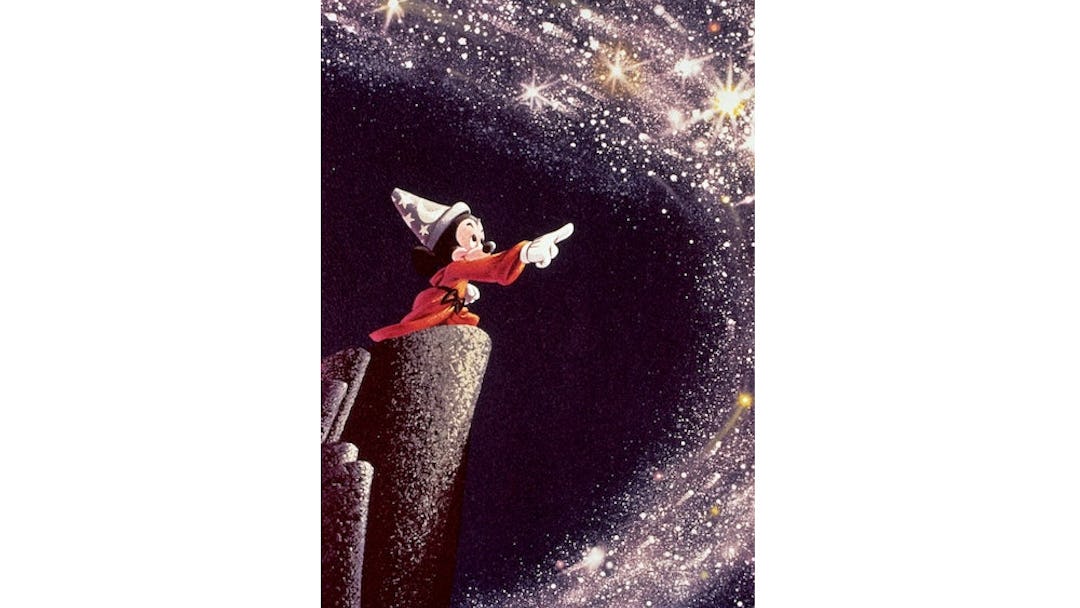Seventy-five years ago today, Walt Disney swung for the fences with his third full-length animated feature (and his second in 1940, following Pinocchio). Fantasia has always been an experience as much as a film: over two hours long (not counting an intermission), requiring installation of a special sound system, with segments including a depiction of evolution on Earth as well as a climax wherein a demon is defeated by the inherent goodness of wandering monks. Hell, an opera commentator emcees it, for God’s sake. Little surprise, then, that in spite of its 1940s-era roadshow release, Fantasia ended up losing more money than Pinocchio, only making anything back after decades of re-releases.
To paraphrase the writer Eli Cash, while we all know that Fantasia was initially a flop, here’s a question worth asking: What if it weren’t? What if Walt Disney’s forward-thinking ambition in 1940 had paid off? What if Fantasia were as influential for feature animation as Snow White and the Seven Dwarfs? Animation junkies know Walt Disney had planned to make Fantasia a recurring event, had it become a hit like Snow White. He and conductor Leopold Stokowski discussed offering an entirely new film to audiences, or a version of the film with some old segments as well as a few new ones. Some ideas made their way to completion — the “Blue Bayou” segment in Make Mine Music would’ve been scored to Debussy’s “Clair de Lune” in a new Fantasia — while others survived only to be mocked by Bette Midler in Disney’s true follow-up, Fantasia 2000. However, because Fantasia lost hundreds of thousands of dollars, its impact was forever muted.
Snow White proved definitively that it was possible for audiences to invest the same emotion in a feature-length animated story as a live-action one. In an alternate universe, an instantly successful Fantasia would’ve proven that animation could be more experimental without alienating the masses, as much as disproving the lie that animation is “just for kids.” (The film’s popularity in the late 1960s and 1970s, repositioned as a drug-trip experience, disproves the lie just as much.) Experimentation is at the core of feature animation, even if the current state of mainstream animation storytelling is typified by high-concept ideas, famous voices, and cultural references. If Fantasia were a hit, we’d see more studios vying for audience attention, but with more diverse finished products; indie artists like Ralph Bakshi and Bill Plympton could display their work to a larger audience. This doesn’t guarantee that audience would be receptive — both Bakshi and Plympton flourish as the polar opposite of Disney animation. But their work wouldn’t need to be Kickstarted; experimental animation would be more viable and less risky.
More importantly, the synthesis of animation and music would be dramatically altered, inspired by Fantasia’s balance of the two. There are a handful of music videos that utilize animation to great effect, from The White Stripes’ Lego-animated “Fell in Love With a Girl,” to Peter Gabriel’s stop-motion “Sledgehammer.” Fantasia could have led to this stylistic choice occurring with greater frequency, and greater impact. Aurally, “Dance of the Hours” has a mildly raucous climax; watching hippos, alligators, and ostriches dance balletically to the Ponchielli piece heightens its buried loopiness. Think what could happen if animators — whether they’re gifted behind a computer or with clay or a pencil — were given free rein to be inspired by music, whether it’s a classical piece such as “Night on Bald Mountain” or Adele’s “Hello.”
Something else Hypothetical Hit Fantasia would’ve altered: how we experience cinema. Disney created the Fantasound system for the film’s roadshow engagements — as big a folly as Snow White, and without the payoff. Now, Fantasound is the norm: Fantasia was the first film released in stereo sound. Then, installing such a distinctive system made it so only two of the theaters where Fantasia played around the country were actual movie theaters; the other 12 were so-called “legitimate theaters” known primarily for the other performing arts, not releasing films. Fantasia 2000 may lack its predecessor’s ambition, but its release strategy was bold: for the first four months of its release, it was only presented in IMAX theaters. To date, it’s the highest-grossing non-documentary IMAX release.
In our world, Fantasia is an exception. It was decades ahead of its time: a technically proficient film in an era when theater exhibitors saw no profit in aural dynamism. If Fantasia was as successful as Walt Disney envisioned when he planned its future, it would have ushered in a period of risk-taking animation where daring moves were demanded, not unexpected. On its 75th anniversary, we should remember that we’re all luckier to live in a world with Fantasia. But how sweet it would be if the riskiest thing Walt Disney ever did was the rule, not the exception.
